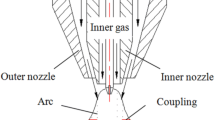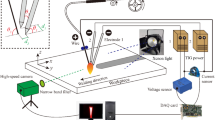Abstract
In order to improve welding efficiency of conventional TIG welding process, a new activating TIG (A-TIG) welding process, named activating arc two-TIG (AT-TIG) welding, was developed by using two-TIG arc activated via mixing minor oxygen into the shielding gas of the front welding torch. The effect of the oxygen flow rate, welding current carried by two tungsten electrodes, and welding speed on the weld formation were investigated for the bead-on-plate welding of SUS304 stainless steel. It was found that, compared to conventional TIG welding, this method can successfully obtain a markedly deepened weld penetration, even at a relatively higher welding speed. Mixing of O2 into the argon shielding gas do not have a significant effect on the microstructure of the weld metal. The dramatically improved weld depth can be achieved at a lower oxygen flow rate and the corresponding impact toughness energy of the weld reaches as much as 92.3% of the workpiece. In addition, the modulation of the current proportions for each welding torch plays a prominent role in the weld formation, which was accounted by a numerical model that the current apportionment for each electrode results in the change of the arc plasma flow and thus the oxygen transfer process from the arc plasma to the weld pool. The predominant effect of the oxygen on the formation of the weld pool shape and the weld formation was demonstrated by a weld-bead-shift experiment. Therefore, the oxygen transfer process from the arc plasma to the weld pool and the mechanisms for enhancing the weld penetration in this welding process were clarified.



















Similar content being viewed by others
Data availability
All data generated or analyzed during this study are included in this published article. The experimental data in this article can be used for scientific research, teaching, etc.
References
Mendez PF, Eagar TW (2003) Penetration and defect formation in high-current arc welding. Weld J 82:296–306. https://doi.org/10.1007/s00421-008-0955-8
Soderstrom E, Mendez P (2006) Humping mechanisms present in high speed welding. Sci Tech Weld Join 11:572–579. https://doi.org/10.1179/174329306X120787
Meng XM, Qin GL, Zou Z (2016) Investigation of humping defect in high speed gas tungsten arc welding by numerical modeling. Mater Design 94:69–78. https://doi.org/10.1016/j.matdes.2016.01.019
Dhandha KH, Badheka VJ (2015) Effect of activating fluxes on weld bead morphology of P91 steel bead-on-plate welds by flux assisted tungsten inert gas welding process. J Manuf Process 17:48–57. https://doi.org/10.1016/j.jmapro.2014.10.004
Cai YC, Luo Z, Huang ZY, Zeng YD (2016) Effect of cerium oxide flux on active flux TIG welding of 800 MPa super steel. J Mater Process Tech 230:80–87. https://doi.org/10.1016/j.jmatprotec.2015.11.008
Kulkarni A, Dwivedi DK, Vasudevan M (2018) Study of mechanism, microstructure and mechanical properties of activated flux TIG welded P91 Steel-P22 steel dissimilar metal joint. Mat Sci Eng A-Struct 731:309–323. https://doi.org/10.1016/j.msea.2018.06.054
Unni AK, Muthukumaran V (2021) Numerical simulation of the influence of oxygen content on the weld pool depth during activated TIG welding. Int J Adv Manuf Tech 112:467–489. https://doi.org/10.1007/s00170-020-06343-1
Sun QJ, Lin SB, Yang CL, Zhang GJ (2009) Penetration increase of AISI 304 using ultrasonic assisted tungsten inert gas welding. Sci Tech Weld Join 14:765–767. https://doi.org/10.1179/136217109X12505932584772
Cook GE, Eassa EH (1985) The effect of high-frequency pulsing of a welding arc. IEEE T Ind Appl 5:1294–1299. https://doi.org/10.1109/TIA.1985.349557
Nomura K, Ogino Y, Haga T, Hirata Y (2010) Influence of magnet configurations on magnetic controlled TIG arc welding. Trans JWRI 39:209–210
Kobayashi K, Nishimura Y, Iijima T, Ushio M, Tanaka M, Shimamura J, Ueno Y, Yamashita M (2004) Practical application of high efficiency twin-arc TIG welding method (SEDAR-TIG) for PCLNG storage tank. Weld World 48:35–39. https://doi.org/10.1007/BF03266441
Leng XS, Zhang GJ, Wu L (2006) Experimental study on improving welding efficiency of twin electrode TIG welding method. Sci Tech Weld Join 11:550–554. https://doi.org/10.1179/174329306X122785
Jiang H, Qin GL, Feng C (2019) High-speed tandem pulsed GTAW of thin stainless steel plate. Weld J 98:215–226. https://doi.org/10.29391/2019.98.019
Modenesi PJ, Apolinario ER, Pereira IM (2000) TIG welding with single-component fluxes. J Mater Process Tech 99:260–265. https://doi.org/10.1016/S0924-0136(99)00435-5
Leconte S, Paillard P, Saindrenan J (2006) Effect of fluxes containing oxides on tungsten inert gas welding process. Sci Tech Weld Join 11:43–47. https://doi.org/10.1179/174329306X77047
Sire S, Marya S (2002) On the selective silica application to improve welding performance of the tungsten arc process for a plain carbon steel and for aluminium. Cr Mecanique 330:83–89. https://doi.org/10.1016/S1631-0721(02)01431-6
Huang Y, Fan D, Shao F (2012) Alternative current flux zoned tungsten inert gas welding process for aluminium alloys. Sci Tech Weld Join 17:122–127. https://doi.org/10.1179/1362171811Y.0000000087
Liu LM, Zhang ZD, Song G, Shen Y (2006) Effect of cadmium chloride flux in active flux TIG welding of magnesium alloys. Mater Trans 47:446–449. https://doi.org/10.2320/matertrans.47.446
Prilutsky VP, Akhonin SV (2014) TIG welding of titanium alloys using fluxes. Weld World 58:245–251. https://doi.org/10.1007/s40194-013-0096-5
Heiple CR, Roper JR (1982) Mechanism for minor element effect on GTA fusion zone geometry. Weld J 61:97–102
Zhang RH, Fan D (2007) Numerical simulation of effects of activating flux on flow patterns and weld penetration in ATIG welding. Sci Tech Weld Join 12:15–23. https://doi.org/10.1179/174329306X147535
Lu SP, Fujii H, Nogi K, Sato T (2007) Effect of oxygen content in He–O2 shielding gas on weld shape in ultra deep penetration TIG. Sci Tech Weld Join 12:689–695. https://doi.org/10.1179/174329307X238425
Dong WC, Lu SP, Li DZ, Li YY (2008) Numerical simulation of effects of the minor active-element oxygen on the Marangoni convection and the weld shape. Acta Metall Sin 44:249–256. https://doi.org/10.3321/j.issn:0412-1961.2008.02.023
Wang XX, Huang JK, Huang Y, Fan D, Guo YN (2017) Investigation of heat transfer and fluid flow in activating TIG welding by numerical modeling. Appl Therm Eng 113:27–35. https://doi.org/10.1016/j.applthermaleng.2016.11.008
Aucott L, Dong HB, Mirihanage W, Atwood R, Kidess A, Gao SA, Wen SW, Marsden J, Feng S, Tong M, Connolley T, Drakopoulos M, Kleijn CR, Richardson IM, Browne DJ, Mathiesen RH, Atkinson HV (2018) Revealing internal flow behaviour in arc welding and additive manufacturing of metals. Nat Commun 9:1–7. https://doi.org/10.1038/s41467-018-07900-9
Lienert TJ, Burgardt P, Harada KL, Forsyth RT, DebRoyb T (2014) Weld bead center line shift during laser welding of austenitic stainless steels with different sulfur content. Scripta Mater 71:37–40. https://doi.org/10.1016/j.scriptamat.2013.09.029
Mishra S, Lienert TJ, Johnson MQ, DebRoy T (2008) An experimental and theoretical study of gas tungsten arc welding of stainless steel plates with different sulfur concentrations. Acta Mater 56:2133–2146. https://doi.org/10.1016/j.actamat.2008.01.028
Zhao CX, Kwakernaak C, Pan Y, Richardson IM, Saldi Z, Kenjeres S, Kleijn R (2010) The effect of oxygen on transitional Marangoni flow in laser spot welding. Acta Mater 58:6345–6357. https://doi.org/10.1016/j.actamat.2010.07.056
Leconte S, Paillard P, Chapelle P, Henrion J, Saindrenan J (2006) Effect of oxide fluxes on activation mechanisms of tungsten inert gas process. Sci Tech Weld Join 11:389–397. https://doi.org/10.1179/174329306X129544
Fujii H, Sato T, Lu SP, Nogi K (2008) Development of an advanced A-TIG (AA-TIG) welding method by control of Marangoni convection. Mat Sci Eng A-Struct 495:296–303. https://doi.org/10.1016/j.msea.2007.10.116
Fan D, Lin T, Huang Y, Niu SF (2008) Arc assisted activating TIG welding process. Trans China Weld Inst 29:1–4. https://doi.org/10.3321/j.issn:0253-360X.2008.12.001
Zhang JX, Huang YQ, Fan D, Zhao JL, Huang JK, Yu XQ, Liu SN (2020) Microstructure and performances of dissimilar joints between 12Cr2Mo1R steel and 06Cr18Ni11Ti austenitic stainless steel joined by AA-TIG welding. J Manuf Process 60:96–106. https://doi.org/10.1016/j.jmapro.2020.10.048
Wang XX, Luo Y, Chi LX, Fan D (2020) Numerical investigation of transport phenomena of arc plasma in argon-oxygen gas mixture. Int J Heat Mass Tran 154:119708. https://doi.org/10.1016/j.ijheatmasstransfer.2020.119708
Murphy AB (1997) Demixing in free-burning arcs. Phys Rev E 55:7473. https://doi.org/10.1103/PhysRevE.55.7473
Murphy AB (1995) Transport coefficients of air, argon-air, nitrogen-air, and oxygen-air plasmas. Plasma Chem Plasma 15:279–307. https://doi.org/10.1007/BF01459700
Murphy AB, Tam E (2014) Thermodynamic properties and transport coefficients of arc lamp plasmas: argon, krypton and xenon. J Phys D Appl Phys 47:295202. https://doi.org/10.1088/0022-3727/47/29/295202/meta
Murphy AB (2012) Transport coefficients of plasmas in mixtures of nitrogen and hydrogen. Chem Phys 298:64–72. https://doi.org/10.1016/j.chemphys.2011.06.017
Sahoo P, Debroy T, McNallan MJ (1988) Surface tension of binary metal-surface active solute systems under conditions relevant to welding metallurgy. Metall Mater Trans B 19:483–491. https://doi.org/10.1007/BF02657748
Lu SP, Fujii H, Nogi K (2009) Arc ignitability, bead protection and weldshape variations for He–Ar–O2 shielded GTA welding on SUS304 stainless steel. J Mater Process Tech 209:1231–1239. https://doi.org/10.1016/j.jmatprotec.2008.03.043
Liu JH, Li XH, Zhou YJ, Yu PJ, He CG, Xu ZB (2022) Microstructure and mechanical properties of active gas arc welding between 304 austenitic stainless steel and Q235B low carbon steel. J Mater Eng Perform 12:1–11. https://doi.org/10.1007/s11665-022-06808-2
Kulkarni A, Dwivedi DK, Vasudevan M (2020) Microstructure and mechanical properties of A-TIG welded AISI 316L SS-Alloy 800 dissimilar metal joint. Mat Sci Eng A-Struct 790:139685. https://doi.org/10.1016/j.msea.2020.139685
Lu SP, Fujii H, Sugiyama H, Tanaka M, Nogi K (2003) Effects of oxygen additions to argon shielding gas on GTA weld shape. ISIJ Int 43:1590–1595. https://doi.org/10.2355/isijinternational.43.1590
Lu SP, Fujii H, Nogi K (2004) Marangoni convection and weld shape variations in Ar–O2 and Ar–CO2 shielded GTA welding. Mat Sci Eng A-Struct 380:290–297. https://doi.org/10.1016/j.msea.2004.05.057
Tanaka M, Shimizu T, Terasaki T, Ushio M, Koshiishi F, Yang CL (2000) Effects of activating flux on arc phenomena in gas tungsten arc welding. Sci Tech Weld Join 5:397–402. https://doi.org/10.1179/136217100101538461
Funding
The National Natural Science Foundation of China (No. 51705054) and The Scientific and Technological Research Program of Chongqing Municipal Education Commission (No. KJQN202101135).
Author information
Authors and Affiliations
Contributions
JZ: investigation, methodology, writing—original draft. PS: investigation, methodology. XW: methodology, funding acquisition, writing and revising, data curation. DF: methodology, supervision.
Corresponding author
Ethics declarations
Ethics approval
The authors state that the present work is in compliance with the ethical standards.
Consent to participate and for publication
All the authors listed have approved the manuscript, consented to participate, and consented for publication.
Conflict of interest
The authors declare no competing interests.
Additional information
Publisher's note
Springer Nature remains neutral with regard to jurisdictional claims in published maps and institutional affiliations.
Rights and permissions
Springer Nature or its licensor (e.g. a society or other partner) holds exclusive rights to this article under a publishing agreement with the author(s) or other rightsholder(s); author self-archiving of the accepted manuscript version of this article is solely governed by the terms of such publishing agreement and applicable law.
About this article
Cite this article
Zhang, J., Shao, P., Wang, X. et al. Improving weld penetration by two-TIG arc activated via mixing oxygen into shielding gas. Int J Adv Manuf Technol 125, 169–181 (2023). https://doi.org/10.1007/s00170-022-10703-4
Received:
Accepted:
Published:
Issue Date:
DOI: https://doi.org/10.1007/s00170-022-10703-4




